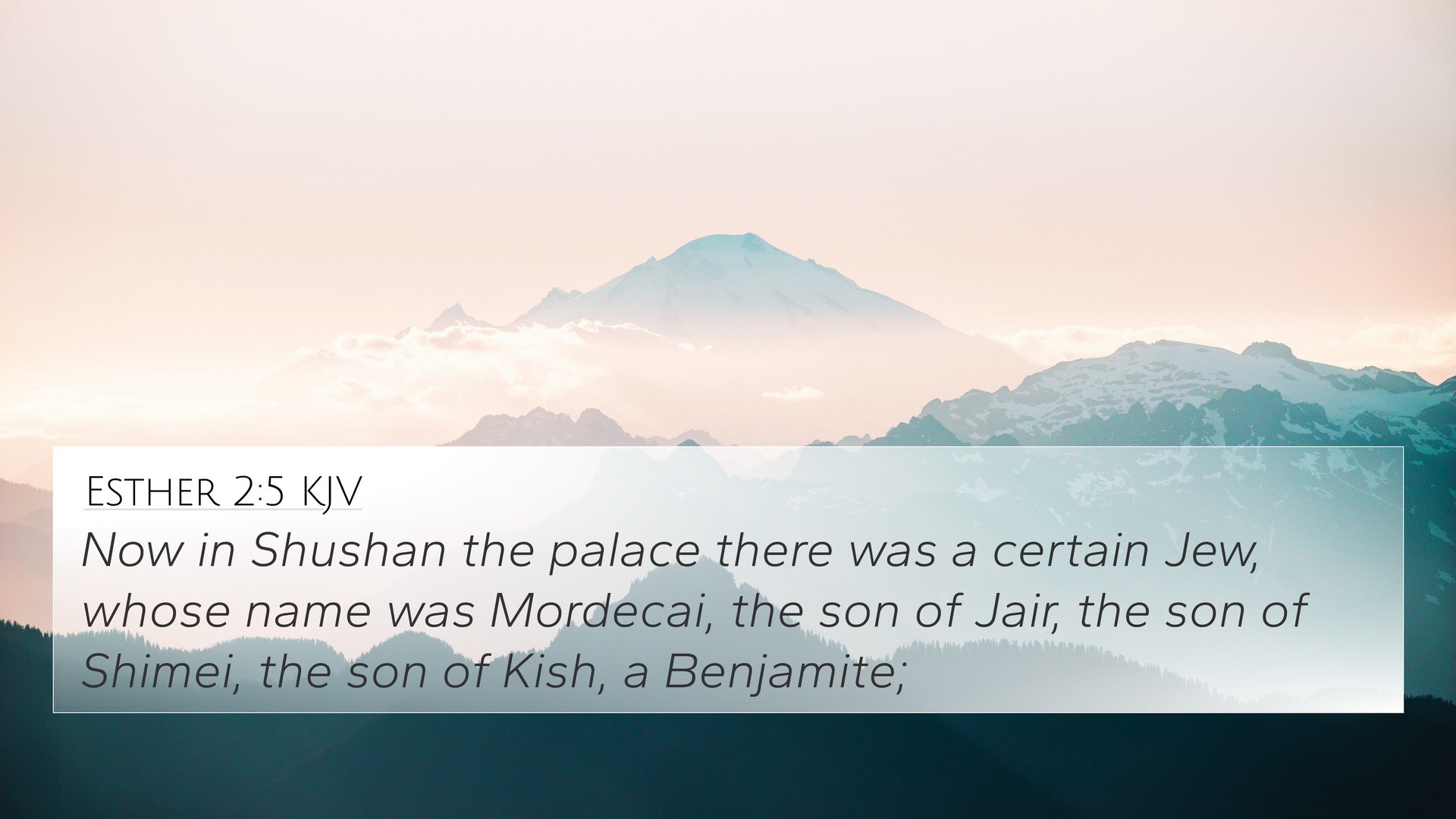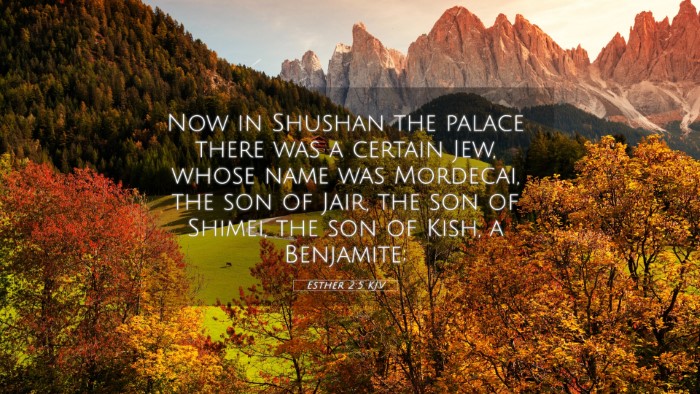Old Testament
Genesis Exodus Leviticus Numbers Deuteronomy Joshua Judges Ruth 1 Samuel 2 Samuel 1 Kings 2 Kings 1 Chronicles 2 Chronicles Ezra Nehemiah Esther Job Psalms Proverbs Ecclesiastes Song of Solomon Isaiah Jeremiah Lamentations Ezekiel Daniel Hosea Joel Amos Obadiah Jonah Micah Nahum Habakkuk Zephaniah Haggai Zechariah MalachiEsther 2:5 Similar Verses
Esther 2:5 Cross References
Now in Shushan the palace there was a certain Jew, whose name was Mordecai, the son of Jair, the son of Shimei, the son of Kish, a Benjamite;
Uncover the Rich Themes and Topics of This Bible Verse
Listed below are the Bible themes associated with Esther 2:5. We invite you to explore each theme to gain deeper insights into the Scriptures.
Esther 2:5 Cross Reference Verses
This section features a detailed cross-reference designed to enrich your understanding of the Scriptures. Below, you will find carefully selected verses that echo the themes and teachings related to Esther 2:5 KJV. Click on any image to explore detailed analyses of related Bible verses and uncover deeper theological insights.
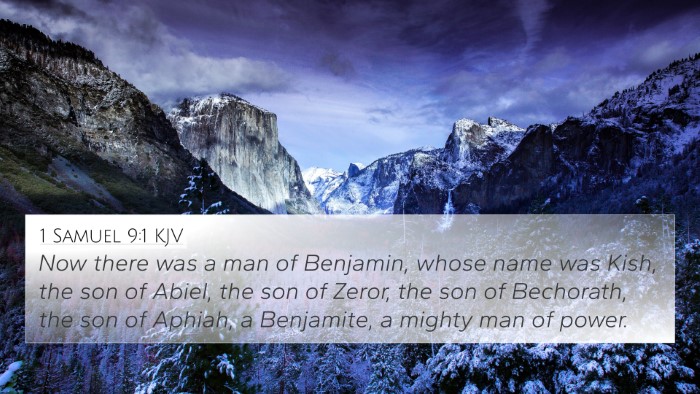
1 Samuel 9:1 (KJV) »
Now there was a man of Benjamin, whose name was Kish, the son of Abiel, the son of Zeror, the son of Bechorath, the son of Aphiah, a Benjamite, a mighty man of power.
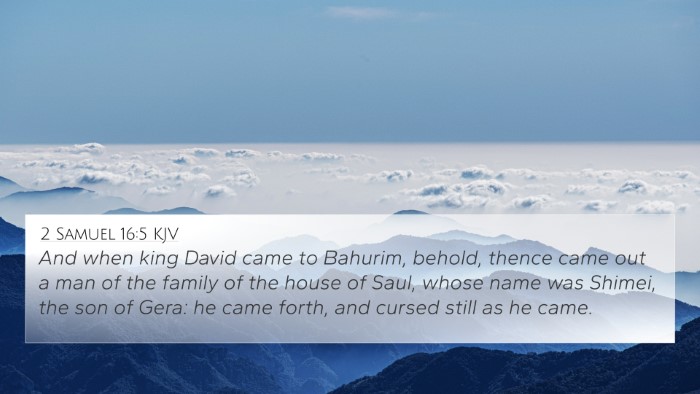
2 Samuel 16:5 (KJV) »
And when king David came to Bahurim, behold, thence came out a man of the family of the house of Saul, whose name was Shimei, the son of Gera: he came forth, and cursed still as he came.
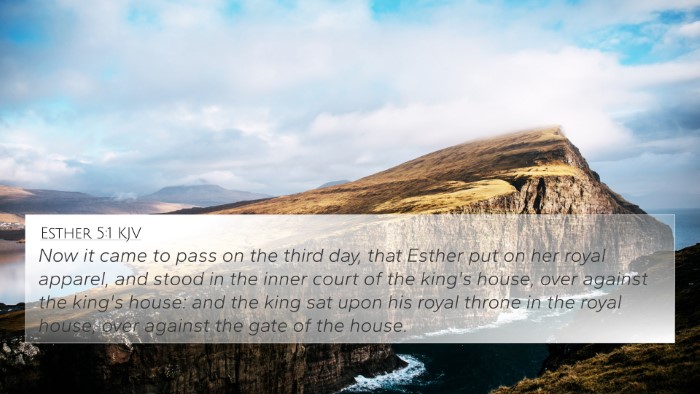
Esther 5:1 (KJV) »
Now it came to pass on the third day, that Esther put on her royal apparel, and stood in the inner court of the king's house, over against the king's house: and the king sat upon his royal throne in the royal house, over against the gate of the house.
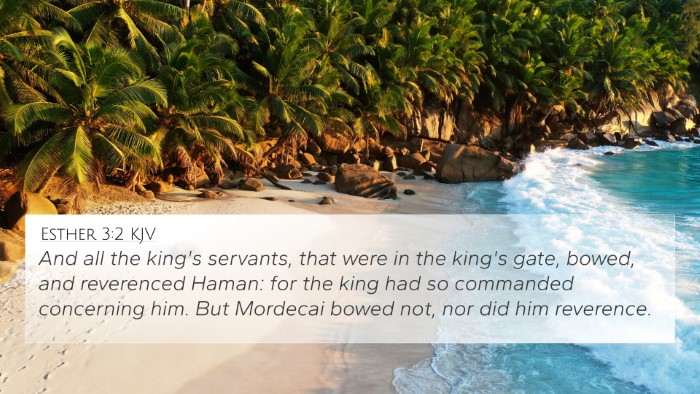
Esther 3:2 (KJV) »
And all the king's servants, that were in the king's gate, bowed, and reverenced Haman: for the king had so commanded concerning him. But Mordecai bowed not, nor did him reverence.

Esther 2:3 (KJV) »
And let the king appoint officers in all the provinces of his kingdom, that they may gather together all the fair young virgins unto Shushan the palace, to the house of the women, unto the custody of Hege the king's chamberlain, keeper of the women; and let their things for purification be given them:
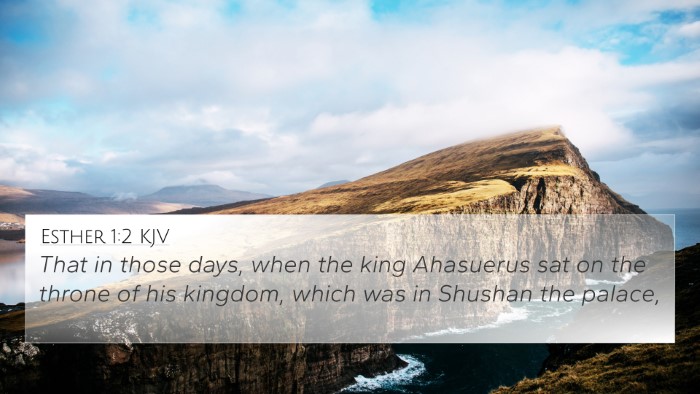
Esther 1:2 (KJV) »
That in those days, when the king Ahasuerus sat on the throne of his kingdom, which was in Shushan the palace,
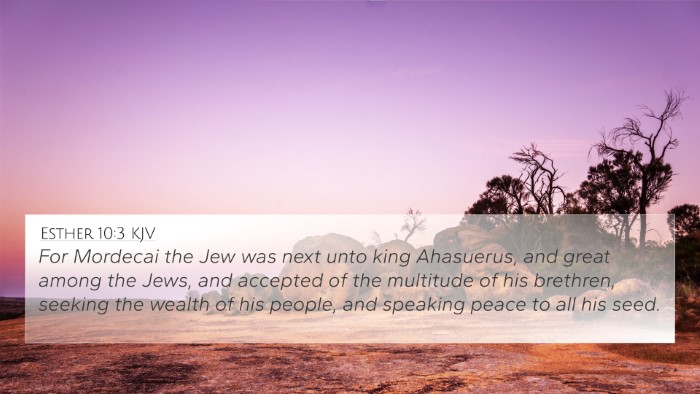
Esther 10:3 (KJV) »
For Mordecai the Jew was next unto king Ahasuerus, and great among the Jews, and accepted of the multitude of his brethren, seeking the wealth of his people, and speaking peace to all his seed.
Esther 2:5 Verse Analysis and Similar Verses
Understanding Esther 2:5
Bible Verse: Esther 2:5 - "Now in Shushan the palace there was a certain Jew, whose name was Mordecai, the son of Jair, the son of Shimei, the son of Kish, a Benjamite;"
Overview of Esther 2:5
This verse introduces a key character in the Book of Esther, Mordecai, establishing his lineage and ethnic background. Mordecai's identity as a Jew and Benjaminite plays a significant role in the unfolding narrative of the Jewish people's deliverance.
Historical Context
The Book of Esther is set in a specific historical context during the Persian Empire's reign. Understanding the backdrop of the Jewish exile, the significance of the city of Shushan (Susa), and the political climate of the time is essential for interpreting this verse.
Mordecai's Significance
- Mordecai's Jewish heritage emphasizes the theme of faith and identity amidst oppression.
- Being a Benjamite ties Mordecai to Saul, the first King of Israel, possibly indicating a legacy of leadership.
- His position in the palace suggests potential influence and opportunity for advocacy for his people.
Cross-References for Deeper Insight
To fully appreciate the implications of Esther 2:5, consider these Bible verse cross-references that illuminate the themes and connections within the text:
- Esther 2:7: Explains Mordecai's role in raising Esther, adding depth to his character.
- Esther 3:2: Highlights the conflict between Mordecai and Haman, central to the story's conflict.
- Esther 4:14: Suggests Mordecai's pivotal role in delivering his people.
- Nehemiah 1:2: Discusses the plight of the Jews, connecting Jewish identity to the larger narrative of restoration.
- Philippians 4:13: Encouragement for believers to stand firm as Mordecai does in the face of peril.
- Romans 11:1: Discusses God's continued relationship with Israel, reinforcing the significance of Jewish identity.
- 1 Timothy 2:1-2: Emphasizes the importance of intercession, akin to Mordecai's protective role over Esther and the Jews.
- Proverbs 21:1: Illustrates God's sovereignty in directing the hearts of kings, paralleling Mordecai’s influence.
- Job 19:25: Posits a hope that is mirrored in Mordecai’s actions and faith in God’s providential care.
- Psalm 137:1-4: Expresses the exiled Jews' longing for their homeland, linking to Mordecai's identity in a foreign land.
Thematic Connections
Esther 2:5 reflects broader themes within Scripture, such as:
- Identity and Heritage: The stress on Mordecai's lineage invites readers to consider their own spiritual heritage.
- God's Sovereignty: Throughout Esther, God’s unseen hand directs events—a motif present in both Old and New Testament narratives.
- Deliverance: Mordecai’s role anticipates themes of God’s salvation for His people, aligning with prophetic texts regarding Israel.
Interpretative Insights
From the insights of public domain commentaries:
- Matthew Henry: Suggests Mordecai’s position shows God’s providence in placing his servants in strategic places of influence.
- Albert Barnes: Emphasizes the importance of ancestry in the Jewish context, instilling a sense of pride and responsibility in Mordecai's actions.
- Adam Clarke: Points out the historical and cultural significance of Mordecai’s role, illustrating the Jewish diaspora's struggles and resilience.
Conclusion
Esther 2:5 is not just an introduction to a character but a portal for exploring themes of identity, sovereignty, and deliverance in the narrative of God's people. Through its connections with other scriptures, it invites readers to engage in a deeper exploration of Biblical truths.
Further Study Recommendations
To enhance your study of Esther and the connections within the Bible:
- Utilize a Bible concordance to cross-reference terms and themes.
- Engage in Bible cross-reference guide methods for comprehensive examination.
- Explore tools for Bible cross-referencing, such as concordances and thematic guides.
- Participate in cross-referencing Bible study groups to discuss implications and applications.
- Consider taking a Bible reference resources approach for systematic study.
